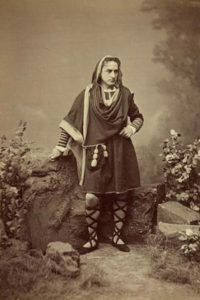It is a great disservice to Mary and the good people at Hal Leonard that it’s taken me this long to get this review up, and for that I apologize. When I opened this book I couldn’t wait to sit down and write about it, but the longer I went the more I realized how … unqualified? … I am do really do this one justice. Who are the greatest Shakespeareans of our time? Kenneth Brannagh, Stacy Keach, Derek Jacobi? You can stand in awe of their abilities upon the stage, but what would you give to sit down and talk with them about their acting history? That’s exactly what Mary Z. Maher did in her book, Actors Talk About Shakespeare. Each chapter is a household name to Shakespeare geeks – Kevin Kline, Kenneth Brannagh, Derek Jacobi, Stacy Keach, Zoe Caldwell, Nicholas Pennell, William Hutt, Martha Henry, Tony Church, Geoffrey Hutchings. (Ok, in all honesty I only know those first four guys – and I only knew of Mr. Keach’s Shakespeare chops thanks to fellow geek David Blixt who haunts my blog from time to time and I believe got a chance to work on Keach’s Lear). This is a book about actors, for actors. Thing is, I’m not an actor. So I can watch Kevin Kline do Hamlet, and I can read a chapter about him explaining what goes into his Hamlet, and it will give me some insight into the man…but what would an actor take away from that chapter? Would an actor walk into his next scene thinking, “How would Kline do it?” even though Kline himself tells stories of walking into auditions asking, “How would Brando do it?” We’ve had some conversations here on the blog that just made me laugh as I saw them come up again in these pages:
The greatest gift [John Barton] brought to American actors is that he disabused them of the notion that there are rules. Folks would say, “But here’s a feminine ending – what does that mean?” He would reply, “It just means that there is a feminine ending.”
Or this gem:
I once had a director who said in opening remarks to the cast, “Good morning. My single rule is that you only breathe at a full stop or colon. No breathing on the commas or the semi-colons.”
I laugh, knowing the battles we’ve had over the importance of punctuation. I can only imagine what it’s like from the actors’ side, having to listen to those instructions and try to follow them. I wish I could tell stories about each chapter, but that would take me forever. Instead I’ll jump to Stacy Keach, because I remember something specific about his method : come to rehearsal with your lines learned cold. He compares it to actors who can’t memorize out of context because they need to know where they’re standing, and so on (advice repeated in our popular article “How to Memorize Shakespeare”, actually). Although it may seem like an Everest in its own right, this means pretty clearly that Keach, a professional actor, still finds value in actually *reading* the play. He’ll no doubt have to worry about beats and breaths soon enough, but for him the two can be separated. There’s the text, and the performance of the text. I like that. But, then, there’s the story of Keach arguing with his director over changing the line “Gather my horses” to “Gather my automobiles.” This merits an argument and a compromise…but Edgar’s redemption scene gets cut completely. That boggles the mind a bit. Well, look, there’s 10 different interviews so I have to stop someplace. I’m an outsider to this process, so at most I’m still reading stories and saying “Oh, that’s neat” much like I might find a nugget of trivia on Kevin Kline’s IMDB page about filming A Fish Called Wanda. (Well, that’s not totally true, I am getting some new insight into the acting process that I did not previously appreciate). But this is a book to be cherished by actors. Maybe you’re lucky enough to have worked with a Stacy Keach or Zoe Caldwell, or maybe you’ve just seen them on tv or on the stage and wished you had such a glimpse into what they do. Well, now you can have that glimpse.

 I could not tell you off the top of my head whether Merchant of Venice is technically supposed to happen in 1275, 1623 or 1941. It is part of what I love. It is what enables people to go to the well over and over and over again, keeping the essence while simultaneously changing everything. If you tried to tell me that there is something about Hamlet that *must* take place in 1601, you’d ruin it for me.
I could not tell you off the top of my head whether Merchant of Venice is technically supposed to happen in 1275, 1623 or 1941. It is part of what I love. It is what enables people to go to the well over and over and over again, keeping the essence while simultaneously changing everything. If you tried to tell me that there is something about Hamlet that *must* take place in 1601, you’d ruin it for me.